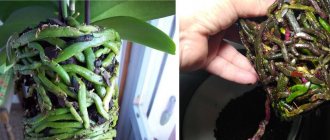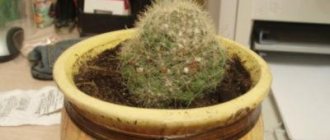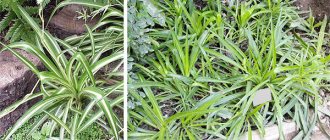Why might a plant die?
The main reasons why a plant dies may be:
- Excessive watering . Overwatering a plant can cause its roots to begin to rot, and if nothing is done right away, the flower will disappear.
- Long stay without moisture . The plant stops receiving nutrients, vital processes stop and it dries out (what to do if spathiphyllum does not grow?).
- Hypothermia of the root system . This may occur if immediately after watering the plant is exposed to cold air.
- Excess of nutrients . Leads to chemical burn of roots. This often happens due to improper use of fertilizers.
Why do spathiphyllum leaves wither, and what to do about it?
Most often, the reasons for the change in color of spathiphyllum foliage lie in non-compliance with the rules of caring for it.
The land is overdried
Rare or insufficient watering leads to the soil becoming dry. It is difficult for the flower to obtain the elements it needs, and there is also an acute lack of moisture. Because of this, the leaves first lose their elasticity and then turn yellow. The earth is covered with a dry crust. It is dangerous to water such a flower suddenly.
First you need to water with half the usual amount of moisture. After the procedure, the flower must be covered with a transparent bag. The next irrigation procedure is carried out a day or two later using the same amount of water.
Heterogeneous soil
Heterogeneity or poor quality of soil leads to a deficiency of nutrients. This leads to drying out of the foliage. You need to replant the plant by filling the pot with a light nutrient mixture with a drainage layer.
Root rotting
Blackening of the tip of the spathiphyllum leaf blade indicates soaking of the roots and the beginning of putrefactive processes. In this case, the flower must be urgently saved, otherwise it will die. The salvation will be replanting into a new pot with fresh soil. Before planting, the root system must be inspected, affected roots must be removed, and the rest must be treated with activated carbon.
Improper watering
Even if spathiphyllum is watered, its foliage may still turn yellow. The reason may be that watering is not systematic (rare or very frequent), cold and hard water is used. It is also detrimental to the plant if excess water remains in the pan after watering. If the leaves are yellowed, but not blackened, and the soil is moist, then most likely watering was frequent, so you need to get rid of excess moisture.
To do this, you need to lay out paper napkins on the surface of the soil, on the leaves, and under the bottom of the flowerpot. When they are saturated with moisture, remove them and lay out new ones. The steps are repeated until the napkins remain dry.
Hypothermia
If the spathiphyllum is left in a draft for a long time, in a cold room, or if there is water left in the tray and the window sill is cold, the leaves begin to turn black at the tips. Moreover, blackness often appears on very young leaves that have not had time to open. Old leaves may droop. Such a flower needs to be removed from the soil and the roots examined. If they are alive, treat with Elin and plant in new soil.
Incorrect plant replanting
Poor quality or unsuitable soil, or a flowerpot of the wrong size, can cause the “female happiness” to begin to turn yellow after transplantation. The soil should be air- and water-permeable, and a layer of drainage should be placed underneath it. The pot is chosen commensurate with the size of the flower. If after transplanting you are not sure whether the soil is suitable, water it and see how it absorbs moisture.
If it’s bad, change the soil to looser, lighter soil with minerals. After changing the pot, do not overwater the flower. It’s better to treat it with Zircon. It will help you quickly adapt to a new place. If you don’t have the drug on hand, you can cover the pot with “women’s happiness” with a transparent bag and leave it like that for a couple of days.
How to understand what is missing?
The plant needs help when such signs appear.:
- The leaves turn black.
- The leaf blades lose their elasticity and become sluggish (why can spathiphyllum droop its leaves?).
- The tops of young leaves darken.
- The foliage turns yellow and dries out.
- The roots become dark and hollow to the touch.
How to determine the cause?
Among many indoor plants, it is spathiphyllum that is easy to diagnose the cause of the disease by its appearance. They are characterized by changes in the color of foliage and petioles.
If the foliage of the plant turns yellow, the turgor deteriorates, and the soil is covered with a dry crust - this is a clear symptom of a lack of fluid. It is also easy to see how old leaves dry out and fall off, and new shoots lose their natural shine.- If the leaves suddenly changed their normal state, bent down, a dark green tint appeared. Perhaps this happened due to hypothermia of the plant. When, after spraying or a warm shower, the window was opened and cold air entered the room.
- Flabby leaves and dry tips indicate dry air in the room.
- The appearance of dark areas with a gray shaggy coating on leaves, stems, and soil is a symptom of the development of fungal diseases, in particular a type of rot.
- If the leaves curl, lean down, and a thin cobweb is visible on them, it means that your plant has neighbors, namely harmful insects. They are often located on the underside and can be easily seen by visual inspection.
Step-by-step instruction
What can I do to revive the plant?
In order to save spathiphyllum, first of all, it is necessary to analyze the conditions under which the flower is kept and understand the possible reason for its poor health.
The tips of the leaves darken
The possible cause of the problem lies:
- In dry air – in this case, it is necessary to take action to humidify the air around the plant.
To do this you can:- Spray spathiphyllum leaves with a spray bottle.
Use a humidifier.
- Place a container of water next to the flower pot.
- In excess watering – in this case, a large area of the edge of the leaf plate turns black. Therefore, you need to know that you cannot flood the plant, and if this happens, you should do the following:
- Trim off browned leaves.
- Dry 1/3 of the soil in which the flower is planted.
- Check to see if excess water is draining from the pot.
- Then reduce the frequency of watering.
You can find out why spathiphyllum flowers and leaves darken here.
Below is a visual and informative video about the reason for the darkening of the leaf tips of spathiphyllum:
The flower turns yellow
This problem may be caused by:
- Sunburn - if the spathiphyllum is exposed to direct sunlight. The leaves lose not only their healthy color, but also their elasticity. They become like a thin sheet of papyrus.
You can fix the problem as follows:- Place the flower in a place with diffused light.
Trim diseased leaves (read more about the main diseases of spathiphyllum here).
- Feed the plant with fertilizer. The complex fertilizer "Reasil" has proven itself well.
- Lack of microelements – in this case, the leaf acquires an uneven yellow color.
You can eliminate the yellowing of spathiphyllum due to a lack of microelements as follows:- Replant the flower in new soil.
Spray the plant with complex fertilizer containing boron and calcium.
- Water the plant with warm and soft water.
Below is a video about the yellowing of spathiphyllum leaves:
The leaves are fading
- Dried soil - the most common cause of leaf wilting. To fix the problem it is enough:
- Water the plant.
- Sometimes, if the soil is very dry, you can completely place the flower pot in a container of water
- Heterogeneous soil – a common cause for newly purchased indoor potted flowers. Store-bought soil absorbs moisture well, but forms a hard lump around the root system, preventing the penetration of oxygen to the roots.
Your actions:- Remove the spathiphyllum from the pot.
Clean the roots as much as possible from the old soil.
- Transplant the flower into new soil, not forgetting the need to create good drainage.
- Root rotting - a reason requiring immediate intervention. It is necessary in a timely manner:
- Remove the plant from the pot.
- Inspect the roots and remove rotten ones with a knife.
- Replant the spathiphyllum or proceed as described below, depending on the results of the examination.
Read more about why spathiphyllum withered and how to save the plant here.
Below is a visual video about resuscitation of a plant when its leaves wilt:
What to do if all the roots have rotted?
Most often, the cause of death of spathiphyllum is problems with the root system. A healthy spathiphyllum root is white and elastic in structure.
If there is a suspicion of rotting of the root system, then the following actions must be taken:
- Remove the plant from the pot.
- Shake off any remaining soil from the roots and rinse them in warm water.
- Carefully examine the root system and use a sharp knife to cut off all rotten roots down to living tissue. Soft, dark and empty roots must also be removed.
- Sprinkle the cut areas with ash or sulfur powder.
- Treat the roots with a weak solution of fungicide or potassium permanganate.
- Leave the plant in the air, allowing the roots to dry out.
- Then place the flower in a container of water with the addition of a root formation stimulator. You can use a folk remedy by dissolving 1 tsp. honey in 1 liter. water.
- The water should be changed regularly.
- As soon as the spathiphyllum begins to grow a root system, it can be planted in the ground.
- When planting, special attention should be paid to the drainage layer.
- The plant is not watered immediately after transplantation.
- In the future, within a month, it is recommended to feed the plant with a root formation stimulator.
The drugs "Epin" and "Zircon" will be excellent helpers in the fight for the life of your pet. A good folk remedy for increasing plant immunity is an infusion of eggshells. To prepare it, you need to pour warm water over the shells of 10 chicken eggs and leave them for a week. This product has an unpleasant odor, but is an effective fertilizer for indoor plants. - When watering, you must ensure that there is no stagnation of water in the pot and remove all excess liquid from the pan in a timely manner.
Next, we suggest watching a video about how spathiphyllum with rotten roots is transplanted:
How to save a plant by replanting?
From the above, we can conclude that replanting is the salvation of a plant from many problems. But this procedure must be carried out correctly, otherwise positive changes will not be seen.
For this:
- Carefully remove the flower from the flowerpot and shake off the soil.
- Rinse off any remaining soil in a container of water.
- Inspect the root system. Leave the light, healthy roots and cut off the rest.
- Sprinkle the sections with powdered activated carbon.
- Place the flower on paper so its roots can dry (2-3 hours).
- Fill the new pot with fresh soil. Mix an activated carbon tablet into it to prevent rotting of the cuts. The soil should consist of leaf soil, peat, coarse sand, charcoal and humus.
- Add drainage. The flowerpot must have drainage holes.
- Moisten the soil and plant the flower in it, moistening the soil a little more after planting.
Important! Carry out the first watering after transplantation two to three days later. Use settled boiled water at room temperature with an admixture
«
Kornevina
»
.
Preventing problems
High-quality care for spathiphyllum will be the main measure to prevent problems with the plant.
- First of all, the plant needs good lighting without direct sunlight. The east or west sides of the house are ideal for maintenance.
- The temperature in the growing area should not be lower than 22 degrees.
- It is necessary to regularly water the plant with warm, settled or boiled water.
- It is necessary to ensure that there is no stagnation of moisture - all water, after watering, should drain into the pan within 15 minutes.
- Every two years the plant needs to replace the soil. When transplanting a plant into new soil, the root system avoids oxygen starvation, which can occur when the soil is compressed.
- Replanting begins when the plant reaches three years.
Spathiphyllum is a spectacular plant. If you follow the rules of care, it will not require resuscitation and will fill your home with beauty.
Why do spathiphyllum leaves wither?
If you notice that the leaves of the spathiphyllum have withered, drooped, or lost their shape, the plant most likely does not receive enough moisture. It's worth watering. If after 1-1.5 hours the situation has not changed, the earthen ball is probably very dry. It is necessary to place the flowerpot in a basin or bucket of water for 15-20 minutes.
If the leaves recovered for a while after watering, and then began to wilt again, the problem lies in the heterogeneity of the soil. The soil looks moist, but in fact the roots of the plant are in a dense, non-hygroscopic lump and are not supplied with sufficient water.
This problem occurs due to improper transplantation when purchasing a plant. At the time of planting in a new pot, the peat substrate was poorly removed from the roots, which in a short time turns into an impenetrable lump. To ensure that the leaves no longer wither, you need to wash the roots in water, carefully freeing them from the old soil, and replant the plant in homogeneous, light soil.
It is worth remembering that wilted leaves are also an indicator of flooding of the root system. In this case, watering will not only be pointless, but also dangerous. By aggravating the situation even further, it can lead to the complete death of the plant.
You can recognize signs of root rot by comparing the last time of watering and the degree of soil moisture. If irrigation has been done for a long time, and the soil is still wet, this indicates that the roots cannot absorb moisture and it begins to accumulate at the bottom of the pot, causing the development of rot. Having diagnosed rotting of the root system, it is necessary to transplant the flower into new soil.
Popular articles Why gooseberries don’t bear fruit: what to do and how to make them bear fruit











